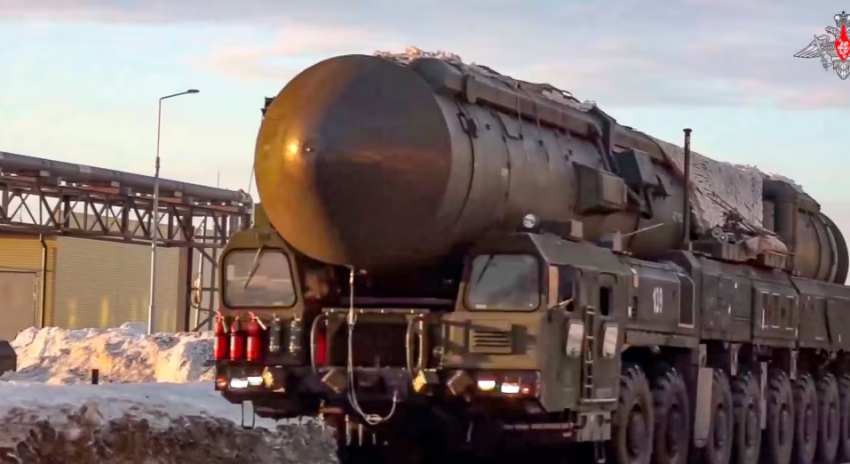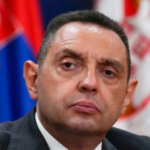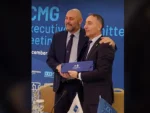President Vladimir Putin has indicated that Russia might modify its nuclear doctrine regarding the use of its atomic arsenal, a message clearly directed at the West to deter increased military support for Ukraine.
He warns that if Kyiv strikes within Russian territory with long-range Western weapons or if NATO deploys troops to Ukraine, it would constitute a major escalation and could lead to a powerful response.
Putin has stated that the country’s nuclear policy is not rigid and could be adjusted based on circumstances.
Since Russia began its aggression against Ukraine in 2022, President Putin and other Kremlin figures have frequently used the nuclear arsenal as a warning to the West.
On the first day of the war, Putin declared that “anyone attempting to hinder us, especially by threatening our country and people, should know that the Russian response will be immediate and with unprecedented consequences.”
Since the war began nearly two and a half years ago, the West has provided Ukraine with sophisticated weaponry worth billions of dollars, some of which have struck within Russian territory. Despite numerous threats from the Kremlin, which has even stationed nuclear weapons in Belarus near the Ukrainian border, Russian warnings have largely remained rhetorical.
So what might trigger a nuclear response?
In June, Putin referred to Russia’s nuclear doctrine when asked about this possibility by international news agencies.
“Look at its formulation. If someone’s actions threaten our sovereignty and territorial integrity, we consider the possibility of using all available means,” said Putin.
Currently, more extreme voices in Moscow are calling for a modification of the doctrine to lower the threshold for nuclear weapon use, and President Putin has acknowledged that the document could be revised based on global developments.
What is Russia’s Nuclear Doctrine?
Officially known as the “Fundamental Principles of State Policy for Nuclear Deterrence,” the doctrine was signed by Putin in 2020 and outlines when Russia might use its atomic arsenal, the largest in the world.
According to the document, nuclear weapons are a “deterrent tool,” and their use would be a “last resort and forced measure.” The doctrine states that Russia “takes all necessary steps to reduce nuclear threats and prevent the deterioration of international relations to the point of military conflicts, including nuclear ones.”
The document emphasizes that “nuclear deterrence aims to make a potential adversary understand that in the event of aggression against the Russian Federation and/or its allies, retaliation is inevitable.”
In What Situations is the Use of Nuclear Weapons Foreseen?
The doctrine allows Russia to use these weapons “in response to the use of nuclear weapons and other types of weapons of mass destruction against it and/or its allies, as well as in case of aggression against the Russian Federation with conventional weapons when the very existence of the state is at risk.”
Specific conditions for activating these weapons include:
— Reliable information on ballistic missile launches targeting Russian or allied territory.
— Use of nuclear or other weapons of mass destruction against Russia or its allies.
— A conventional attack threatening the existence of Russia.
— Attacks on critical government or military facilities that could undermine the country’s capability for a nuclear response.
Have There Been Attacks Near the Threshold for Nuclear Use?
After Russia attacked parts of northeastern Ukraine near Kharkiv, Washington allowed Kyiv to use long-range weapons supplied by the U.S. to strike targets within Russian territory. However, the range of these strikes has been limited and does not appear to pose an existential threat according to the nuclear doctrine.
Nonetheless, more extreme voices in Moscow have mentioned Ukrainian attacks on Russian airbases housing long-range nuclear-capable aircraft and strikes on early warning radar systems. They argue that these instances justify the use of nuclear weapons as per the doctrine.
Russian officials have not commented on attacks on sensitive targets. Early warning radars aim to detect potential missile launches so Russia can activate its missiles and prevent their destruction.
James Acton, co-director of the nuclear policy program at Carnegie, recently noted that Ukrainian attacks on early warning radars might lead the Kremlin to believe Washington is encouraging such attacks to weaken Russia’s nuclear deterrent system.
“If Moscow believes Washington might carry out a successful preemptive strike against its nuclear forces, it increases the risk that Russia might undertake a large-scale nuclear strike based on false or misinterpreted alarms,” he said.
What Changes are Being Considered?
Kremlin nuclear threats have recently decreased as Moscow has made battlefield progress in Ukraine. However, there have been calls within Russia to revise the nuclear doctrine, and Putin has stated that it might be modified based on global developments.
Some voices have repeatedly called for making the doctrine more stringent, arguing that the current document is too soft and open to interpretation. They claim that the doctrine has not deterred the West from increasing aid to Ukraine and gives the impression that Moscow would never use nuclear weapons.
Dmitry Trenin, an external relations expert at the Kremlin-funded World Economy and International Relations Institute, suggests revising the doctrine to allow Russia to be the first to strike with nuclear weapons when “vital national interests are at risk,” as in the case of Ukraine.
“The urgent task in the third year of military confrontation is to prevent further NATO involvement,” he says.
“If we don’t do this, continued Western escalation will lead to a direct clash between the Russian army and NATO, which carries the risk of a global nuclear war.”
Sergei Karaganov, a foreign policy expert advising the Kremlin, has also urged President Putin to revise the doctrine by lowering the threshold for nuclear weapon use.
“I hope it will be changed soon to officially give you the right to respond to any attack on our territory with a nuclear strike,” he said to the Russian leader during a forum in St. Petersburg.
“I hope such a provision will be added to our doctrine so that our adversaries will be deterred,” he continued.
President Putin stated that he currently does not see threats that would justify the use of nuclear weapons but left the possibility of revising the document open.
“This doctrine is an adaptable instrument. We are closely following what is happening in the world around us and do not rule out changes,” he said.
The need to modify the document, he said, has been driven by concerns that the West is considering low-yield nuclear weapons. Putin did not provide details, but his comments may refer to discussions in the U.S. about deploying low-yield nuclear missiles launched from submarines.
Proponents of this idea argue that such weapons are needed to counter Russian threats, while critics contend that they would increase the risk of war.
“We are aware of ideas circulating among Western experts about developing extremely low-yield nuclear devices and that they might be used. In itself, this is not something particularly terrifying,” said Putin. “But it is our duty to closely monitor such developments, and this is exactly what we are doing.”







